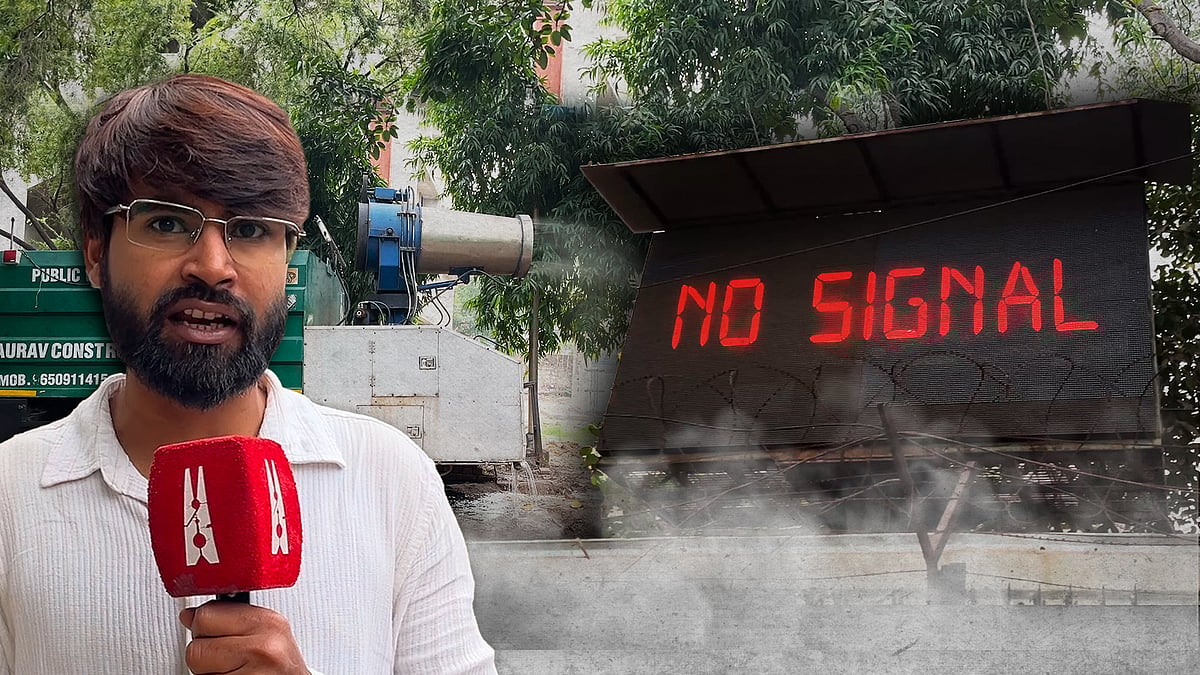
Newslaundry had earlier reported how several of Delhi’s air quality monitoring stations were themselves in violation of basic norms, placed behind trees, beside walls, or hemmed in by buildings that obstruct airflow within the mandatory 20-metre radius. But it seems even that wasn’t enough. As the city’s air turned poisonous again this season, reports and on-ground findings suggest the government has gone a step further, not to fight pollution, but to massage the numbers that measure it.
At Jahangirpuri – one of Delhi’s 13 officially declared pollution “hotspots” – Newslaundry found Public Works Department (PWD) tankers spraying water around an air quality monitoring station located inside the Industrial Training Institute campus.
Suraj, the driver of one such anti-smog tanker, said his duty was assigned by the PWD, and that the watering continued from 11 am to 5 pm every day. “We spray water near the monitor twice a day,” he said. “Apart from me, three or four more tankers come here every day.”
The Delhi government had promised a nine-point action plan for every pollution hotspot, including road cleaning, pothole repair, garbage removal, debris clearance, and controlled sprinkling to settle roadside dust. But the ground reality at Jahangirpuri looked like the exact opposite: cratered roads, mounds of dust, heaps of garbage, and construction rubble lying untouched.
Instead, the one spot that stayed regularly watered and “clean” was the area around the pollution monitor.
It was hard to miss the pattern, and locals said the same. Ramesh Kumar, who runs a paratha stall near the ITI, said he has never seen the anti-smog tankers near his shop. “There’s so much dust that I have to wipe the counter every five minutes,” he said. “If I stand on the roadside, my eyes burn and my throat starts hurting.”
When Newslaundry contacted Delhi’s PWD minister Parvesh Singh Verma’s office, we were directed to his media advisor, Animesh Chaudhary, who did not respond to a request for comment. A questionnaire has been sent to both the minister and his office. This report will be updated if a response is received.
According to environmentalist Vimlendu Jha, spraying water directly near a monitoring unit can significantly distort readings.
“If water is sprayed near an air quality monitor, the recorded pollution levels will appear lower,” he explained. “Nearly 40 percent of Delhi’s air pollution is caused by dust particles. Watering near the monitor suppresses that dust, reducing the data artificially…the readings will definitely go down.”
Jha further warned that this practice not only hides the government’s failure to curb pollution but also endangers public health in the long run. “By doing this, the government can manipulate data and protect its image. But the long-term impact on governance, policy-making, and citizens’ health is deeply concerning and dangerous,” he said.
Amid allegations of data manipulation by AAP leader Saurabh Bhardwaj and reports of water sprinklers circling air quality monitors, Newslaundry had earlier visited the Anand Vihar air monitoring station, one of Delhi’s most polluted spots, to verify the claims.
Bhardwaj had earlier posted a video showing two tankers spraying water around the sensors, accusing the Delhi government of trying to artificially lower AQI readings.
On Monday, no truck-mounted water sprinklers were seen near the station. Yet, the ground around it was still visibly wet. About 50 metres away, near the Anand Vihar bus terminal, a water truck driver said, “We’ve been instructed, since the video went viral, not to go there.”
Karamat, a 39-year-old who has been driving the truck for five years, had said, “We make rounds at Anand Vihar bus terminal, Chaudhary Charan Singh Marg, among others.” Asked if they were assigned to spray near the monitoring station, he said, “We used to drive there earlier, but not since the video went viral.”
Here’s how you can join the Fight To Breathe. Click here to power the collaborative campaign.
Newslaundry is a reader-supported, ad-free, independent news outlet based out of New Delhi. Support their journalism, here.







